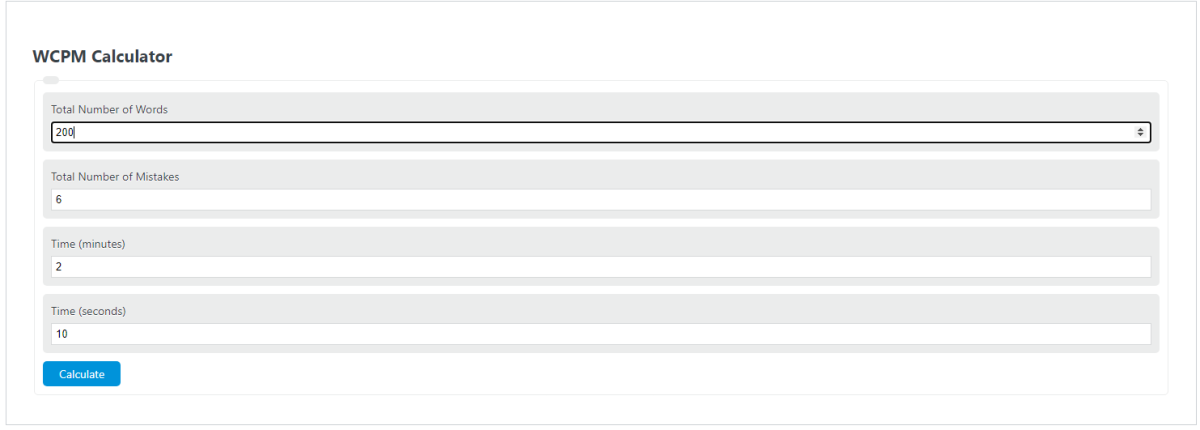Enter the total number of words, the total number of mistakes, and the time to determine the words correct per minute (WPCM).
- Error Rate Calculator
- Quiz Grade Calculator
- Sampling Error Calculator
- GWAM (Gross Words Per Minute) Calculator
WCPM Formula
The following formula is used to calculate the total number of words correct per minute.
WCPM = [TW - M] / T
- Where WCPM is the words correct per minute
- TW is the total number of words in the reading
- M is the total number of mistakes made while reading the passage
- T is the total time in minutes.
To calculate WCPM, subtract the number of mistakes made from the total number of words read, then divide by the total time in minutes.
The formula for the time and further be broken down into the following:
T = m + S/60
- Where m is the number of minutes
- S is the number of seconds
What is WCPM?
WCPM is an accroynm that stands for words correct per minute. It’s a metric used in teaching to understand the reading comprehension of students.
Students are asked to read a passage and the the better they do, the higher there words correct per minute is.
This value takes into account not only how fast the student reads by also how many mistakes they make, so a student rushing through a passage but making mistakes would not score higher than one taking there time with little mistakes.
Example Problem
How to calculate WCPM?
First, determine the total number of words in the passage. For this example, the students are given a passage that has a length of 200 words.
Next, have the student read the passage and record the time and number of mistakes.
In this case, the student reads the passage in 2 minutes and 10 seconds and made a total of 6 mistakes.
Finally, calculate the WCPM using the formula above:
WCPM = [TW – M] / T
WCPM = [200 – 6] / (2 + 10/60)
WCPM = 89.53.
FAQ
Why is WCPM important?
WCPM is important because it provides a measurement of a student’s reading fluency, which is critical for success in school and in life. A high score indicates that a student can read quickly and accurately, which is essential for comprehending complex text and retaining information.
What is an average WCPM score?
The average WCPM score varies depending on a student’s age and grade level, but a general benchmark for upper elementary school students is around 100-150.
What factors affect WCPM scores?
Factors that can affect WCPM scores include a student’s reading level, prior knowledge, comprehension skills, and motivation. It’s also important to note that scores can fluctuate over time, as students develop new skills and gain more experience.
How can WCPM be improved?
WCPM can be improved through a variety of strategies, including providing students with challenging texts, encouraging them to practice reading regularly, and providing opportunities for guided reading instruction and feedback. It’s also important to ensure that students have the background knowledge and vocabulary necessary to comprehend complex text.
How is WCPM used in the classroom?
WCPM is often used in the classroom to monitor student progress, set goals, and inform instructional decisions. It can be used as a diagnostic tool to identify areas of weakness and to target instruction, and as a formative assessment tool to track progress over time.
How can WCPM be used to inform instruction?
WCPM can be used to inform instruction by providing information about a student’s reading level, strengths, and areas for improvement. This information can be used to select appropriate texts, provide targeted instruction, and set achievable goals for improvement.
How does WCPM relate to other measures of reading fluency?
WCPM is just one measure of reading fluency, and it’s important to consider it in conjunction with other measures, such as accuracy, comprehension, and prosody. These measures provide a more comprehensive picture of a student’s reading abilities and can inform instructional decisions.
How can WCPM be used to support English language learners?
WCPM can be used to support English language learners by providing a measurement of their reading fluency and accuracy. This information can be used to select appropriate texts, provide targeted instruction, and set achievable goals for improvement.
